THE SCIENCE BEHIND BODY FAT AND WEIGHT LOSS
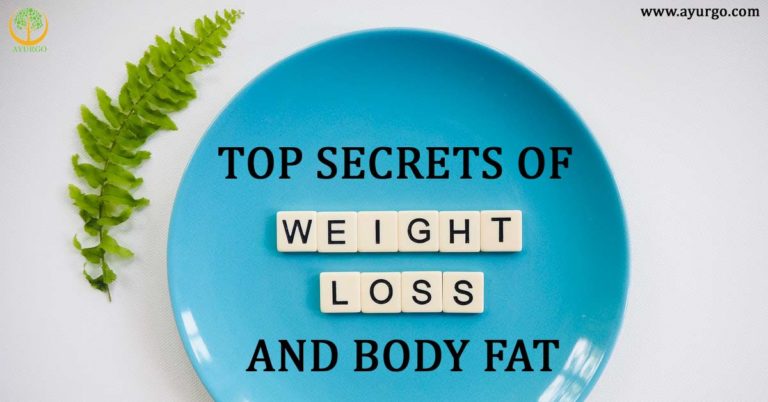
Every day, everywhere we’re bombarded with countless numbers of advertisements and articles, all telling about WEIGHT LOSS or HOW TO LOSE FAT.
But, Do you know our bodies already know how to lose FAT?
As we eat, our body converts our food into glucose, a simple sugar that travels through our bloodstream.
This glucose is the primary food for ourselves, whether it’s a muscle cell, or a brain cell, or cell in our heart, they all feed on glucose.
As glucose moves through our bloodstream, our pancreas produces a hormone called INSULIN.
Insulin is the gatekeeper of our cells, it opens the door allowing glucose to enter and be used for our energy needs, and without it, our cells can’t be fed.
What if we eat more than we need?
Well, along with our brain cells and muscles cells, we also have fat cells, our cells never eat more than they need.
So when we have more glucose than our cells can use, the excess amount is stored in our fat cells, where it is converted into free fatty acids.
Once the glucose is out of the bloodstream with our cells having been fed and the surplus having been stored away in our fat cells, then Insulin closes the doors to our cells and slowly leaves our body.
When our body needs more energy or glucose and we don’t have any food handy, it turns to the fat cells and the free fatty acids stored inside them.
The free fatty acids leave our fat cells and go right back to the bloodstream to feed all our other cells, they don’t need Insulin to open the cell doors, that’s why they’re referred to as free Fatty Acids.
This natural process of storing fat when you have too much glucose and burning fat when you don’t have enough glucose is how your body was designed to work, and in a perfect world, eating an ideal diet everything works perfectly.
Unfortunately, we don’t live in an ideal world and most people don’t even come close to eating a perfect diet.
As a result, we don’t benefit from this natural process fairly often; instead, we suffer by storing too much fat and rarely burning any.
Let’s look at a typical breakfast in our imperfect world.
When we rise up in the morning, the very first thing most people have is a breakfast fairly high in sugar and processed foods, when this type of food enters our body, it is converted into glucose very quickly and rushes into the bloodstream.
The more sugary the food, the faster and higher our blood sugar level rises
Our pancreas senses this sudden spike in glucose and responds by pumping out the Insulin, creating an insulin spike to correspond to the fats rising glucose.
Insulin does its job and opens the door to our cells, all our working cells are fed and all the excess glucose is then stored in our fat cells.
Now, this process happens fast, once insulin arrives, the glucose level in our bloodstream goes back down pretty quickly. however, it takes much longer for insulin to get out of our body,
So albeit the glucose level in our bloodstream comes down fairly quickly, our Insulin level remains high and this could be a big problem, because as long as there is insulin still in our body, we can’t access the free fatty acids stored in our fat cells.
Remember, free fatty acids don’t require insulin to allow them into the cells, but they do need Insulin to be gone before they can leave our fat cells.
Our body needs to eat continually but the free fatty acids can’t leave the fat cells on come the cravings, the irritability, and so we eat.
Our glucose level spike, right back up our body releases even more insulin, the door is open, the cells are once again fed, and excess glucose is put into our fat cells.
With our insulin level remaining high, we’re still unable to release any fatty acids, so we continue adding to the fat storage but never taking any out.
This cycle continues through lunch, mid-afternoon snacks, dinner, and so on.
We literally end up bathing our bodies and insulin all day long and for much of the night, after a while, all that insulin takes a toll.
We age much faster than normal and many of us develop type 2 Diabetes.
As I said, our body already knows how to lose fat but the next question that comes in the mind is:
Why and how our body stores fat?
For a better understanding of this subject, let’s take an example of a steam engine and our body.
The Steam engine needs fuel to operate and so does the human body, coal is fed as fuel to the steam engine, food is fed as fuel to the human body.
Coal is burned to get energy for the Steam Engine; food is burned to get energy for the human body.
Let’s assume, some amount of coal is not burned and left in the engine, the remaining coal is stored inside the engine so that it can be used later.
What if the stored coal is not used first, but more coal is put in?
Obviously, the new coal will be used first.
What if some of the new coal also remains, again it will be stored, if this process continues, there will be a time when the Engine will be full of stored coal and no new coal can be put in.
Similarly, if some of the food is not burned and left in the human body, the remaining food is stored inside the body so that it can be used later.
What if the first stored food is not used for energy but more food is taken?
Obviously, the new food will be burned for energy.
What if some of this new food also remains?
Again it will be stored.
If this process continues, there will be a time, when the human body will have a lot of stored food.
This example is to explain how our body works and stores foods in a layman term.
Let’s get to the details of it.
Fuel is equal to food is equal to calories is equal to energy.
Yes, the food we eat is measured in a unit called Calories.
One calorie also called a large calorie is defined as the amount of energy it would take to raise the temperature of one kilogram of water by one degree Celsius.
Everything we consume has calories;
- The average pizza slice has about 272 calories,
- A piece of bread has about 78 calories,
- And an apple has about 52 calories.
Our body requires energy for each and every task, even when we are sleeping, we are still breathing, food is being digested, and blood is circulating inside our body.
So the food we eat or the calories we intake is converted into energy, the process of converting food into energy is called metabolism.
This energy is known as glucose. Glucose is a form of simple sugar; the glucose travels through our bloodstream and is the main form of energy for all our cells.
Our body feeds on glucose that is why glucose drips are given to sick patients so that their body can get direct energy without having to go through the process of converting food into glucose.
We have already discussed how glucose is turned into fats and vice versa.
The next thing we need to know is-
How do I make sure my body does not store fat?
It’s simple, burn all the calories that you intake,
And how do I burn the calories?
The calories you eat are burned by performing three main tasks:
- Digestion
- Physical activity
- Supporting the basic functions for organs and tissues
On an average, the amount of calories required for a man to perform all these tasks is about 2700 calories, for women, it is about 2200 calories.
So, if an average man who does a desk job eats exactly 2700 calories a day, then all the calories will be burned and there won’t be any fat storage in the body.
But, if he eats more than that, let’s say 3000 calories, then he has to do something to burn the additional 300 calories, otherwise, it will be stored as fat.
Now, he cannot use that for digestion, or support body functions, because they have already been taken care of by 2700 calories.
So the only thing remaining is physical activity. He has to do additional physical activity to burn the remaining 300 calories.
It means the more and more additional calories he eats, he has to burn it by more physical activity.
If no additional physical activities are performed, the additional calories are stored in fat cells.
That is how a person gains weight and that is why burning fat involves more physical activities.
Now we need to understand:
How does exercise impact weight loss?
In humans, there is a fine balance between energy intake and energy expenditure.
Energy intake is in the form of food and energy expenditure is in the form of BASAL metabolic rate and physical activity.
The difference between energy intake and energy expenditure is known as the net energy balance.
If energy intake exceeds the expenditure, then a net positive energy balance occurs,
Energy expenditure depends on a variety of things, this includes
- The starting weight,
- The basal metabolic rate,
- Physical activity
With reference to physical activity, there are several key variables including the frequency, intensity, duration, and sort of activity done.
Let us examine energy consumption:
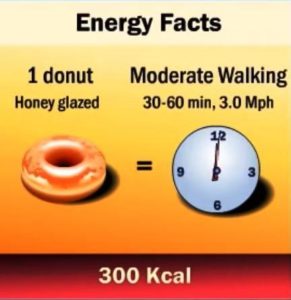
One honey glazed donut has approximately 300 kilocalories; the energy intake from the consumed donut is equal to the energy consumed by moderate walking for 30-60 minutes at 5km/h.
If an individual walks for an hour at 5 km/hr. they will expend approximately 300 kilocalories as what was contained in the consumed donut.
Thus, Moderate walking for 1 hour at approximately 5 km/hr would result in weight loss.
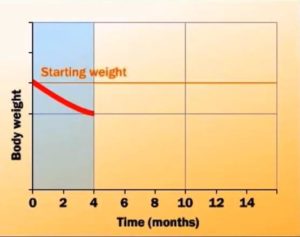
This assumes that the individual doesn’t consume any extra calories and has net negative energy expenditure.
If this continues for a period of 2-4 months, body weight is reduced as depicted.
The initial weight loss is the result of a negative net energy balance, the negative energy balance is because energy expenditure exceeds energy intake.

After the initial weight loss, the individual continues to the same type of exercise that is one hour of moderate walking daily.
The chart depicts changes in body weight over time.
Individuals are often frustrated and surprised that the weight is not continuing to decreases despite regular walking.
Here they need to understand that they have reached a plateau.
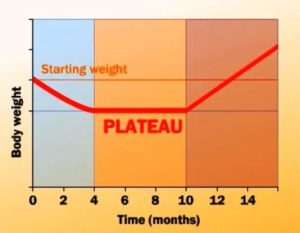
The reason behind the weight loss plateau is that with decreased weight, the BASAL metabolic rate also decreases,
When the basal metabolic rate decreases, there is a decrease in total energy expenditure.
If the discouraged individual quits their daily routine exercise, the weight starts increasing at a quicker pace as a result of a positive energy balance being created.
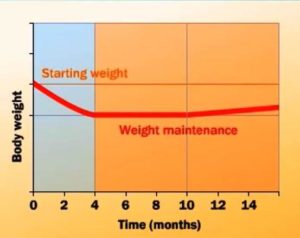
As physical activity is stopped, energy expenditure is also reduced.
By keeping an equivalent intensity and duration of walking, without making any changes within the diet energy intake, the individual would enter a weight maintenance phase. This is characterized by gaining a small amount of weight.
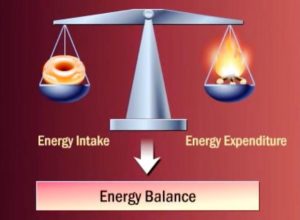
The weight maintenance is due to an energy balance being established within the body, where energy intake is equal to energy expenditure.
If there’s no change in energy balance, there’ll not be any more change in weight.
What must be done to end the weight loss plateau?
Several options exist to take care of a negative net energy balance, these involve either decreasing energy intake or increasing energy expenditure.
Options include:
- Restricting calories further
- Increasing the frequency or the intensity or the duration of the exercise.
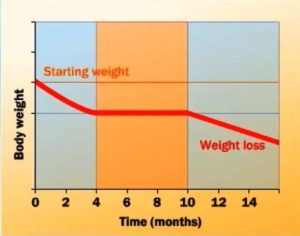
In summary, weight plateaus are expected and can only end with continued exercise and a net negative energy balance.
Stopping exercise or increasing calories will result in weight gain.
If one continues to exercise to take care of a net negative energy balance, weight loss will be promoted.
At this point, a question might come in our minds, when you burn off those excess fats:-
How does fat leave the body?
Till now, we have understood that the stored fat is used for energy, well YES that is true, we read about energy until now, but now, we will talk about its MASS.
When you lose fat, you lose weight, this weight of fat, when used for energy, doesn’t just vanish, there is some chemistry happening behind it.
Our body does a lot of chemical reactions throughout the day that is why we refer our inner body feelings as chemistry.
Burning fat also involves a chemical reaction, now to keep things simple I won’t be explaining the entire chemical reactions happening while burning fat, it’s super complicated.
For now, just refer to this image
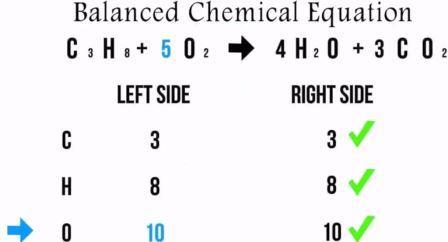
In chemistry, there is something called the law of conservation of mass, this simply states that:
During a chemical reaction, mass can neither be created nor destroyed, it is converted from one form to another.
The mass of the products in a chemical reaction must be equal to the mass of the reactants, that is why we always write balanced chemical equations, which means, number of atoms before reaction should always be equal to the number of atoms after the reaction.
Every fat molecule has mass, when fat is burned, this mass doesn’t just vanish, as per the law of conservation of mass, it is converted into other forms which also has an equal amount of mass as that of fat before burning.
Let me clear it with an example:
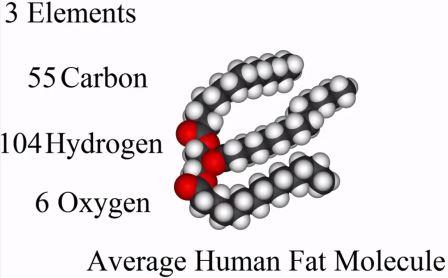
The average human fat molecule is made up of 3 elements, CARBON, HYDROGEN, and OXYGEN.
It contains 55 carbon atoms, 104 Hydrogen atoms, and 6 oxygen atoms, this is the chemical formula of an average human fat molecule.
Now, the oxygen you inhale reacts with the fat molecule to break down the fat and release its energy.

To lose just one of these fat molecules, you have to inhale 78 molecules of Oxygen as the chemical process occurs; you convert this fat molecule into 55 molecules of carbon dioxide, and 52 molecules of water.
So after this reaction, the atoms just didn’t vanish, but they have changed into something new.
I hope you are getting it now.

So if we calculate the number of atoms on both sides, we can see 55 carbon atoms, 104 hydrogen atoms, and 162 oxygen atoms.
Hence, mass is conserved and the law is not broken.
So that’s the chemical process that burns fat and releases energy in your body, and talking about the mass, it is converted into carbon dioxide and water.
YES, when you burn fat, that piece of jelly and giggly fat leaves your body as carbon dioxide and water.
You literally breathe out you fat, the heavier you breathe, the more fat you will lose.
You must keep in mind that you cannot just sit there and do heavy breathing to lose fat. That’s called HYPERVENTILATION, and this can result in dizziness and loss of consciousness.
You have to actually move your body in a way that naturally creates the HUFFING and PUFFING.
Now, let’s understand the mass distribution.
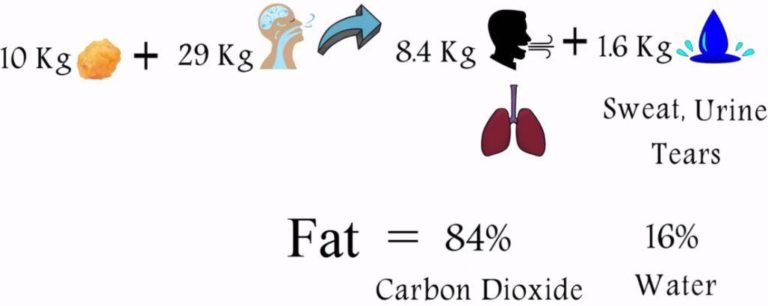
If your body has 10 kg of fat, to burn it, you will need to inhale 29 kg of oxygen, then the chemical reaction happens after that 8.4 kg of carbon dioxide is produced which you exhale and 1.6 kg of water is produced, which comes out of your body as sweat, urine, and even tears.
This means that 84 % of fat leaves your body as carbon dioxide and only 16 % of fat leaves in the form of water.
So now you finally understood that when you lose fat, it goes out of your body as carbon dioxide and water.
By this time, all your doubts must be cleared regarding WEIGHT LOSS and body fat.
If you keep in mind the mechanism of formation and dilution of Body Fat, it will be much easier for you to plan your diets aiming for weight loss.
